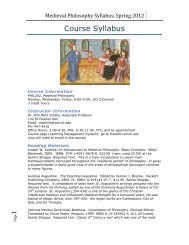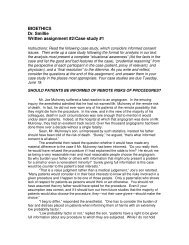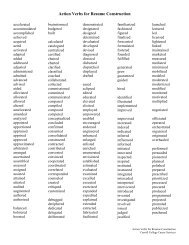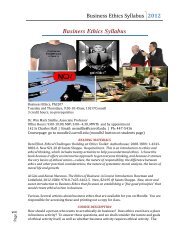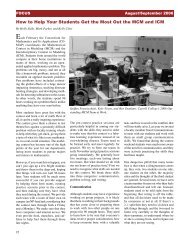Spatial Risk Mapping of West Nile Virus in ... - Carroll College
Spatial Risk Mapping of West Nile Virus in ... - Carroll College
Spatial Risk Mapping of West Nile Virus in ... - Carroll College
You also want an ePaper? Increase the reach of your titles
YUMPU automatically turns print PDFs into web optimized ePapers that Google loves.
<strong>Spatial</strong> <strong>Risk</strong> <strong>Mapp<strong>in</strong>g</strong> <strong>of</strong> <strong>West</strong> <strong>Nile</strong><br />
<strong>Virus</strong> <strong>in</strong> Correlation to Vegetation <strong>in</strong><br />
Montana<br />
Submitted <strong>in</strong> partial fulfillment <strong>of</strong> the requirements for graduation with honors from the<br />
Department <strong>of</strong> Natural Sciences at <strong>Carroll</strong> <strong>College</strong>, Helena, MT<br />
Amanda Wreggelsworth<br />
<strong>Carroll</strong> <strong>College</strong>, Helena, MT<br />
March, 2013
3<br />
April 1, 2013<br />
TABLE OF CONTENTS<br />
ACKNOWLEDGEMENTS……………………………………………………………....4<br />
ABSTRACT……………………………………………………………………………....5<br />
INTRODUCTION………………………………………………………………………...6<br />
MATERIALS AND METHODS………………………………………………………10<br />
RESULTS………………………………………………………………………………..13<br />
DISCUSSION……………………………………………………………………………17<br />
APPENDIX ……………………………………………………………….….21<br />
LITERATURE CITED……………………………………………………………….….27
4<br />
Acknowledgements<br />
I would like to thank Dr. Hokit, Dr. Shields, and Dr. Johnson for their guidance and<br />
support throughout this project. I would also like to thank Max Bernt, Graham Unis, and<br />
Tyler Jacobson for their help collect<strong>in</strong>g samples and Pr<strong>of</strong>essor Stewart and Dr. Alvey for<br />
review<strong>in</strong>g my document. I would like to acknowledge <strong>Carroll</strong> <strong>College</strong> for the resources<br />
and space needed to complete this study. This project was supported by Grant Number<br />
P20 RR16455-09 from the National Center for Research Resources (NCRR), a<br />
component <strong>of</strong> the National Institutes <strong>of</strong> Health (NIH).
5<br />
Abstract<br />
In the present study, spatial epidemiology was applied to the vegetation <strong>in</strong><br />
Montana by comb<strong>in</strong><strong>in</strong>g NDVI data, landcover data, and a thermal layer to create a<br />
predictive model <strong>of</strong> C. tarsalis <strong>in</strong> Montana. Samples <strong>of</strong> C. tarsalis, which has been<br />
identified as the primary vector for <strong>West</strong> <strong>Nile</strong> <strong>Virus</strong> <strong>in</strong> Montana, were collected from<br />
June to August, 2013, at various sites across the state. ArcGIS and MaxENT s<strong>of</strong>tware<br />
was used to create a model for June, July, and August. Overall, there was a modal<br />
correlation between vegetation density and the presence <strong>of</strong> C. tarsalis and a positive<br />
correlation between both the thermal and vegetation layers and the presence <strong>of</strong> C.<br />
tarsalis. The models and their correspond<strong>in</strong>g data outputs provide <strong>in</strong>sight <strong>in</strong>to mosquito<br />
presence throughout Montana, an outcome which, <strong>in</strong> turn, may help isolate WNV hot<br />
spots.
6<br />
Introduction<br />
<strong>West</strong> <strong>Nile</strong> <strong>Virus</strong> (WNV), a member <strong>of</strong> the family Flaviviridae, is one <strong>of</strong> 73<br />
species <strong>in</strong> the genus Flavivirus (Ayers et al., 2006). This genus can be divided <strong>in</strong>to the<br />
mosquito-borne viruses, the tick-borne viruses, and a third for which no vectors have<br />
been identified (Ayers et al., 2006). WNV represents one <strong>of</strong> the mosquito-borne viruses<br />
and is considered to be <strong>of</strong> global importance (Yadav et al., 2012). WNV may have been<br />
present <strong>in</strong> the Middle East for centuries but was not isolated <strong>of</strong>ficially until 1937, <strong>in</strong> the<br />
<strong>West</strong> <strong>Nile</strong> District <strong>of</strong> Uganda (Griffith, 2005, Gossel<strong>in</strong> et al., 2005). WNV was detected<br />
<strong>in</strong> Morocco <strong>in</strong> 1996, Israel from 1998-2001, Italy <strong>in</strong> 1998, and France <strong>in</strong> 2000 and 2004<br />
(Ward, 2009). Romania and Russia have also suffered from outbreaks <strong>of</strong> WNV recently<br />
(Ward et al., 2005). In 1999, WNV made its debut <strong>in</strong> the United States, <strong>in</strong> New York City<br />
(Ezenwa et al., 2006).<br />
Once <strong>in</strong> the United States, the virus spread outwards <strong>in</strong> a radial pattern <strong>in</strong>stead <strong>of</strong><br />
follow<strong>in</strong>g the flight paths <strong>of</strong> birds (Venkatesan and Rasgon, 2010). Between 2001 and<br />
2002, WNV spanned a remarkably large geographic area (Venkatesan and Rasgon,<br />
2010). By the end <strong>of</strong> the transmission season, the virus had crossed the Mississippi River<br />
<strong>in</strong>to the Midwest and Great Pla<strong>in</strong>s (Venkatesan and Rasgon, 2010). At that po<strong>in</strong>t, 44<br />
states had been <strong>in</strong>vaded by the virus; and <strong>in</strong> 2003, the virus reached the <strong>West</strong> Coast<br />
(Venkatesan and Rasgon, 2010). An explosion <strong>of</strong> cases accompanied the expansion <strong>of</strong> the<br />
virus (Cooke et al., 2006). The United States faced the largest WNV epidemic ever<br />
documented to date <strong>in</strong> 2002, with 4156 human cases and 284 deaths (Cooke et al., 2006).<br />
In 2003, the number <strong>of</strong> human cases reached 9000 nationwide, with 220 deaths (Cooke et
7<br />
al., 2006). Cases <strong>of</strong> the virus predom<strong>in</strong>ately occur <strong>in</strong> late summer or early fall <strong>in</strong> the<br />
temperate latitudes (Griffith, 2012).<br />
WNV is a vector-borne zoonotic disease that cycles between birds and<br />
mosquitoes (Brownste<strong>in</strong> et al., 2002, Ruiz et al., 2004). Humans, horses, and a number <strong>of</strong><br />
other vertebrates are considered <strong>in</strong>cidental or dead-end hosts (Ruiz et al., 2004). Wild<br />
birds serve as the primary reservoir hosts, but the most competent avian WNV hosts tend<br />
to be passeriform birds (Ezenwa et al., 2006). Historically and currently, WNV has<br />
posed a threat to the animals mentioned above. Specifically <strong>in</strong> Montana, the American<br />
White Pelican (Pelecanus erythrorhynchos) population has been damaged (Johnson et al,<br />
2006-2007. As <strong>of</strong> 2007, over 400 pelican chicks have died each year s<strong>in</strong>ce the orig<strong>in</strong>al<br />
outbreak <strong>in</strong> 2002 because <strong>of</strong> WNV (MSU News Service, 2012). Pelican deaths may<br />
<strong>in</strong>dicate <strong>in</strong>creased risk for WNV transmission to persons liv<strong>in</strong>g nearby (CDC, 2010).<br />
For a human <strong>in</strong>fection to occur, the conditions must not only promote virus<br />
amplification with<strong>in</strong> avian and mosquito populations, but also lead to a spillover <strong>in</strong>to the<br />
<strong>in</strong>cidental host groups (Ezenwa et al., 2006). S<strong>in</strong>ce the first outbreak, scientists have<br />
found that the vector, Culex tarsalis, is the most common carrier <strong>of</strong> WNV <strong>in</strong> Montana.<br />
Elsewhere, Aedes vexans, Culex qu<strong>in</strong>quefasciatus, Culex pipiens, Culex restuans, and<br />
Culex nigripalpus have been important vectors (Johnson et al., 2010). C. tarsalis<br />
possesses the ability to perpetuate viral amplification <strong>in</strong> bird reservoirs, bridge the virus<br />
to mammalian hosts, and travel long distances to seek blood meals or oviposition sites<br />
(Venkatesan and Rasgoon, 2010). Accord<strong>in</strong>g to multi-locus cluster<strong>in</strong>g analyses, three<br />
clusters <strong>of</strong> C. tarsalis populations are present <strong>in</strong> the United States: the Sonoran cluster<br />
(near Mexico), the Pacific cluster (the <strong>West</strong>ern coastal, montane, and <strong>in</strong>termontane
8<br />
regions), and the Midwest cluster (<strong>in</strong>clud<strong>in</strong>g Montana) (Venkatesan and Rasgoon, 2010).<br />
The virus had spanned across all three clusters by 2004 (Venkatesan and Rasgon, 2010).<br />
The <strong>in</strong>cubation period <strong>of</strong> <strong>West</strong> <strong>Nile</strong> <strong>Virus</strong> ranges from 2-14 days (Griffith,<br />
2012).Once <strong>in</strong>fected, the symptoms <strong>of</strong> the disease are similar to St. Louis encephalitis,<br />
with a fairly wide range <strong>of</strong> symptoms (Ruiz et al., 2004). Many people who are <strong>in</strong>fected<br />
with the virus tend to experience only mild symptoms such as fever, headache, and sk<strong>in</strong><br />
rash (Griffith, 2012). However, less than 1% <strong>of</strong> people <strong>in</strong>fected with WNV develop a<br />
more serious illness, their symptoms rang<strong>in</strong>g from high fever to paralysis and coma to<br />
death (Griffith, 2012). Higher-risk people are those who are age 50 and up, those who<br />
work outdoors, and those with lower immune systems (Griffith, 2012).<br />
Physicians and state <strong>of</strong>ficials are <strong>in</strong>terested <strong>in</strong> new and efficient methods for<br />
monitor<strong>in</strong>g the spread <strong>of</strong> disease and predict<strong>in</strong>g future outbreaks (Cooke et al., 2006).<br />
One such method is spatial epidemiology, the study <strong>of</strong> spatial variation <strong>in</strong> disease<br />
<strong>in</strong>cidence or risk (Ostfeld et al., 2005). This method has arisen as the pr<strong>in</strong>cipal scientific<br />
discipl<strong>in</strong>e committed to understand<strong>in</strong>g both the causes and consequences <strong>of</strong> spatial<br />
heterogeneity <strong>in</strong> <strong>in</strong>fectious diseases (Ostfeld et al., 2005.) <strong>Spatial</strong> epidemiology assesses<br />
a variety <strong>of</strong> factors <strong>in</strong>clud<strong>in</strong>g socioeconomic factors, geographic factors, and<br />
environmental factors (Elliot and Wartenberg, 2004).<br />
A specific environmental factor that is assessed us<strong>in</strong>g spatial epidemiology is<br />
vegetation. Vegetation is an important variable <strong>in</strong> assess<strong>in</strong>g WNV risk because its<br />
abundance is specifically associated with the presence <strong>of</strong> human cases (Brownste<strong>in</strong> et al.,<br />
2002). Vegetation not only provides a rest<strong>in</strong>g and breed<strong>in</strong>g site for mosquitoes, but also
9<br />
provides avian hosts, a refuge from predators, carbohydrate resources for flight energy,<br />
and the necessary resources needed for reproduction and pathogen acquisition (Cooke et<br />
al., 2006, Brownste<strong>in</strong> et al., 2002). In New York City, spatial analysis <strong>of</strong> WNV case<br />
distribution found that vegetation abundance was significantly and positively associated<br />
with human <strong>West</strong> <strong>Nile</strong> <strong>Virus</strong> cases (Gibbs et al., 2006). A commonly used measure <strong>of</strong><br />
vegetation density is the Normalized Differentiated Vegetation Index (NDVI; Ozdenerol<br />
et al., 2008). Previously, NDVI data have been useful <strong>in</strong> predict<strong>in</strong>g the distribution <strong>of</strong><br />
disease vectors like tsetse flies and mosquitoes (Ozdenerol et al., 2008). As the most<br />
commonly used vegetation <strong>in</strong>dex <strong>in</strong> health studies, NDVI data provide a comprehensive<br />
grow<strong>in</strong>g season pr<strong>of</strong>ile <strong>of</strong> different ecosystems, which is useful for evaluat<strong>in</strong>g seasonal<br />
variations <strong>in</strong> vegetation conditions (Ward, 2009, USGS, 2011). Other studies <strong>of</strong><br />
vegetation and occurrence <strong>of</strong> WNV have been completed <strong>in</strong> other states, such as<br />
California; however, few studies have been carried out <strong>in</strong> Montana (Ezenwa 2005,<br />
Montana State University, 2012). These studies <strong>in</strong>clude data layers for vegetation type<br />
and density but not a comb<strong>in</strong>ed data layer (USGS, 2012). Comb<strong>in</strong><strong>in</strong>g the proposed<br />
vegetation data layer with a thermal data layer may improve models that attempt to<br />
predict the distribution <strong>of</strong> C. tarsalis.<br />
In the present study, spatial epidemiology will be applied to the vegetation <strong>in</strong><br />
Montana by comb<strong>in</strong><strong>in</strong>g NDVI data, landcover data, and a thermal layer (Murphy, 2012)<br />
to create a predictive model <strong>of</strong> C. tarsalis <strong>in</strong> Montana. My study explores two<br />
hypotheses. The first is that there will be no correlation between vegetation and the<br />
presence <strong>of</strong> C. tarsalis. A second hypothesis is that a correlation exists between the<br />
thermal layer and presence <strong>of</strong> C. tarsalis but not between both the thermal and vegetation
10<br />
layers and presence <strong>of</strong> C. tarsalis. If a correlation <strong>in</strong>deed exists between both the thermal<br />
and vegetation layers and presence <strong>of</strong> C. tarsalis, then WNV should be more easily<br />
predicted us<strong>in</strong>g the comb<strong>in</strong>ed model, and better prevention and control programs could<br />
be put <strong>in</strong> place.<br />
Materials and Methods:<br />
Location:<br />
Montana is located <strong>in</strong> the Rocky Mounta<strong>in</strong> region <strong>of</strong> the United States between 44° 26'N<br />
to 49°N (longitude) and 104° 2'W to 116° 2'W (latitude) (Netstate, 2012). The most<br />
abundant vegetation types are Grasslands (44.73%), Evergreen Forest (21.6%),<br />
Shrubland (8.69%), and Fallow (7.7%) (USGS Earth Explorer, 2012).<br />
Figure 1 Field sites with the presence <strong>of</strong> Culex tarsalis
11<br />
Sample Collection:<br />
Mosquito samples were obta<strong>in</strong>ed us<strong>in</strong>g CDC light traps at sites throughout Montana (Fig.<br />
1). Depend<strong>in</strong>g on the location, either a CO 2 tank or dry ice was used as an attractant. The<br />
traps were operational from dusk to dawn, placed approximately three feet <strong>of</strong>f the<br />
ground. Once transported back to the lab at <strong>Carroll</strong> <strong>College</strong>, the samples were placed <strong>in</strong> a<br />
-20 ° C freezer for approximately 24 hours. The samples were then sorted to isolate C.<br />
tarsalis. C. tarsalis mosquitoes were identified based on the follow<strong>in</strong>g characteristics:<br />
median band<strong>in</strong>g on the proboscis, a rounded abdomen, wide basal and apical band<strong>in</strong>gs on<br />
each tarsal, and the presence <strong>of</strong> th<strong>in</strong> scales on the dorsal w<strong>in</strong>g surface (Figure 2; James<br />
Gathany, 2005). The latitude and longitude coord<strong>in</strong>ates for the sites that had at least one<br />
C. tarsalis mosquito present were recorded and transferred to a spread sheet. Onehundred<br />
fifteen sites throughout Montana had at least one C. tarsalis present. Locations<br />
at which no C. tarsalis were collected were omitted from this study.<br />
Figure 2 C. tarsalis specimen labeled with dist<strong>in</strong>guish<strong>in</strong>g characteristics by James Gathany, 2005
12<br />
Environmental Variables:<br />
Vegetation data layers provid<strong>in</strong>g vegetation density and landcover type data were<br />
obta<strong>in</strong>ed from the USGS. These data layers were adapted to ASCII format us<strong>in</strong>g<br />
ArcMap10.1. ArcGis s<strong>of</strong>tware was used to resample the layers to 1000m x1000 m square<br />
plots for the state <strong>of</strong> Montana. The layers were also converted to a common projected<br />
coord<strong>in</strong>ate system (NAD 1983 State Plane Montana FIPS 2500) and a common datum<br />
(North American 1983). The aforementioned conversions were required for use by<br />
MaxEnt (Young et al., 2011). The landcover data set was chosen because <strong>of</strong> the number<br />
<strong>of</strong> landcover categories. Insufficient categories would not provide enough <strong>in</strong>formation<br />
and an excess <strong>of</strong> categories could cause over-fitt<strong>in</strong>g <strong>of</strong> the MaxEnt model. The landcover<br />
data set used <strong>in</strong> the current study <strong>in</strong>cluded twenty different landcover types. The<br />
vegetation density data set, known as the Normalized Differentiated Vegetation Index,<br />
was chosen because <strong>of</strong> its use <strong>in</strong> several past studies, specifically <strong>in</strong> New York and<br />
Connecticut (Ezenwa et al., 2006; Brown et al., 2008). Also, the data set was updated<br />
every month, a necessary procedure for this project. The NDVI dataset was cont<strong>in</strong>uous,<br />
and the landcover data set was categorical. The thermal data was created by Murphy<br />
(2012) and resampled and converted <strong>in</strong> the same manner as the vegetation layers.<br />
Model Development:<br />
MaxEnt, a model<strong>in</strong>g program, uses presence-only data, environmental data, and<br />
maximum entropy theory to determ<strong>in</strong>e habitat suitability (Phillips et al., 2004). This<br />
program projects the probability that the species <strong>of</strong> <strong>in</strong>terest will occur at any given po<strong>in</strong>t<br />
(Phillips et al., 2004).
13<br />
To beg<strong>in</strong> the MaxEnt process, a sample file <strong>in</strong>clud<strong>in</strong>g the presence localities <strong>of</strong> C.<br />
tarsalis, <strong>in</strong> .csv format, was loaded <strong>in</strong>to the program. This file conta<strong>in</strong>ed 115 north<strong>in</strong>g and<br />
east<strong>in</strong>g values converted from the latitude and longitude coord<strong>in</strong>ates recorded at each trap<br />
site. The environmental layers were loaded next. The output was set to logistic and the<br />
boxes “create response curves,” “make pictures <strong>of</strong> predictions,” and “do jackknife to<br />
measure variable importance” were checked. The model was then run and the results<br />
were saved to output files. The output <strong>of</strong> MaxEnt produced several tables and figures that<br />
illustrate how well the model fits the data and how relevant the model is statistically.<br />
MaxEnt was run three times with the NDVI and landcover data, once for each<br />
month <strong>of</strong> the study: June, July, and August. MaxEnt was run separately each month to<br />
<strong>in</strong>crease the trials for each model type and to analyze and compare results from month to<br />
month. The same process was repeated for June, July, and August with thermal data <strong>in</strong><br />
addition to the vegetation layers. The first three runs were considered the first cycle and<br />
then next three runs were considered the second cycle.<br />
Results<br />
First Cycle: Vegetation<br />
Model<strong>in</strong>g vegetation with MaxEnt resulted <strong>in</strong> several statewide maps <strong>of</strong> C.<br />
tarsalis habitat (Figs 3, 4, and 5). A map was produced for the vegetation data for the<br />
months <strong>of</strong> June, July, and August, with AUC values <strong>of</strong> 0.854, 0.876, and 0.889,<br />
respectively. An AUC value above 0.5 <strong>in</strong>dicated that the projected model predicts C.<br />
tarsalis location better than random chance. A value <strong>of</strong> 1.0 <strong>in</strong>dicates perfect<br />
predictability.
14<br />
Environmental variables that were <strong>in</strong>corporated <strong>in</strong>to these models were vegetation<br />
type (landcover data) and vegetation density (NDVI data). For each month, landcover<br />
type had a stronger role <strong>in</strong> the model, with higher percent contributions than NDVI<br />
(Table 1).<br />
Table 1: Relative contribution <strong>of</strong> environmental features to the model <strong>in</strong> predict<strong>in</strong>g the distribution <strong>of</strong> C. tarsalis for<br />
June, July, and August.<br />
Month<br />
Environmental Variable<br />
Percent<br />
Contribution to<br />
the Model<br />
June<br />
Landcover 83.6<br />
NDVI 16.4<br />
July<br />
Landcover 76.1<br />
NDVI 23.9<br />
August<br />
Landcover 70.4<br />
NDVI 29.6<br />
The jackknife plots were all similar (Figs. 6-8). The environmental variable that<br />
contributed most to resolution is the landcover data. This result <strong>in</strong>dicates that landcover is<br />
the most useful variable when analyz<strong>in</strong>g that data set <strong>in</strong>dependently <strong>of</strong> the other<br />
variables. The environmental variable that decreases the ga<strong>in</strong> the most when omitted<br />
from the model is landcover. This <strong>in</strong>dicates that landcover data had the most <strong>in</strong>formation<br />
content.<br />
MaxEnt also produced a set <strong>of</strong> response curves, for the variables landcover and<br />
NDVI, where each variable was used <strong>in</strong>dependently <strong>in</strong> produc<strong>in</strong>g the model. For each<br />
month, the top four types <strong>of</strong> landcover that had the biggest effect on the model were: Low
15<br />
Intensity Residential, Commercial/Industrial/Transportation, Urban/Recreational Grasses,<br />
and Woody Wetlands (Figs. 9-11). Evergreen Forest was the landcover type that<br />
produced the lowest effect on the model. Another set <strong>of</strong> response curves <strong>in</strong>dicated that<br />
the presence <strong>of</strong> C. tarsalis is negatively correlated with vegetation density (NDVI) for the<br />
months <strong>of</strong> June and August and positively correlated with the month <strong>of</strong> July (Figs. 12-<br />
14).<br />
Second Cycle: Vegetation and Thermal<br />
The second cycle <strong>of</strong> MaxEnt resulted <strong>in</strong> adjusted statewide maps <strong>of</strong> C. tarsalis<br />
habitat (Figs. 15-17). A map was produced for the vegetation and thermal data for the<br />
months <strong>of</strong> June, July and August, with AUC values <strong>of</strong> 0.910, 0.921, and 0.941,<br />
respectively. These values are higher than <strong>in</strong> the previous set <strong>of</strong> models, <strong>in</strong>dicat<strong>in</strong>g that<br />
add<strong>in</strong>g the thermal area <strong>in</strong>creased its predictability.<br />
Environmental variables <strong>in</strong>corporated <strong>in</strong>to the second cycle <strong>of</strong> models were<br />
vegetation type (landcover data), vegetation density (NDVI data), and the thermal layer<br />
created by Murphy (2012). For each month, landcover type had a stronger role <strong>in</strong> the<br />
model, with higher percent contributions (Table 2). The variables that differed were the<br />
NDVI and thermal data. For the months June and August, the thermal layer contributed to<br />
the model more than the NDVI layer. For the month <strong>of</strong> June, the NDVI layer contributed<br />
more to the model than did the thermal layer.<br />
The jackknife plots for the second cycle are similar for the months <strong>of</strong> June, July,<br />
and August (Figs. 18-20). For all three plots, landcover had the highest ga<strong>in</strong>, followed by<br />
the thermal data, and then the NDVI data. This f<strong>in</strong>d<strong>in</strong>g <strong>in</strong>dicated that landcover<br />
contributed the most to the model and NDVI contributed the least.
16<br />
Table 2: Relative contribution <strong>of</strong> environmental features to the model <strong>in</strong> predict<strong>in</strong>g the distribution <strong>of</strong> C. tarsalis<br />
June, July, and August.<br />
Month<br />
Environmental Variable<br />
Percent<br />
Contribution to the<br />
Model<br />
Landcover 59.4<br />
June<br />
NDVI 16.9<br />
Thermal 23.7<br />
Landcover 54.8<br />
July<br />
NDVI 23.6<br />
Thermal 21.6<br />
Landcover 43.6<br />
August<br />
NDVI 24.8<br />
Thermal 31.5<br />
The response curves for landcover produced from the second cycle were similar<br />
to the response curves for the first cycle. For each month, these four landcover categories<br />
had the biggest effect on the model: Low Intensity Residential,<br />
Commercial/Industrial/Transportation, Urban/Recreational Grasses, and Woody<br />
Wetlands (Figs. 21-23). As before, the landcover type Evergreen Forest had the lowest<br />
effect on the model. The response curves for vegetation density (NDVI) <strong>in</strong>dicated that<br />
the presence <strong>of</strong> C. tarsalis is negatively correlated with vegetation density for the months<br />
<strong>of</strong> June and August and positively correlated for the month <strong>of</strong> July (Figs. 24-26). The<br />
third set <strong>of</strong> response curves <strong>in</strong>dicated that the presence <strong>of</strong> C. tarsalis positively correlates<br />
with the thermal data (Figs. 27-29).
17<br />
Discussion<br />
The objective <strong>of</strong> this study was to analyze a model conta<strong>in</strong><strong>in</strong>g vegetation density,<br />
landcover, and thermal data to locate mosquito hot spots. The model that resulted from<br />
this experiment predicted habitat suitability for C. tarsalis with an AUC value <strong>of</strong> 0.924.<br />
This value <strong>in</strong>dicates that the models from the second cycle have a high predictability for<br />
habitat suitability, as a value <strong>of</strong> 1.00 <strong>in</strong>dicates perfect prediction. S<strong>in</strong>ce the second cycle<br />
phase conta<strong>in</strong>ed the highest AUC value, the data <strong>of</strong> the first cycle will not be further<br />
discussed. Overall, a modal correlation existed between vegetation density and the<br />
presence <strong>of</strong> C. tarsalis. The modal distribution showed that low- and high-density<br />
vegetation conta<strong>in</strong>ed the lowest predicted presence <strong>of</strong> C. tarsalis, and medium-density<br />
vegetation showed a strong correlation between density and the predicted presence <strong>of</strong> C.<br />
tarsalis. Thus, we reject the first hypothesis that no correlation exits between vegetation<br />
and the presence <strong>of</strong> C. tarsalis. Accord<strong>in</strong>g to the response curves located <strong>in</strong> the Appendix<br />
(Figures 24-29), there is a positive correlation between both the thermal and vegetation<br />
layers and the presence <strong>of</strong> C. tarsalis. Orig<strong>in</strong>ally, it was hypothesized that no correlation<br />
would exist between the comb<strong>in</strong>ation <strong>of</strong> the thermal and vegetation layers and the<br />
presence <strong>of</strong> C. tarsalis, so the second hypothesis was rejected as well.<br />
Previous studies, <strong>in</strong> states other than Montana, have <strong>in</strong>vestigated the effects that<br />
landcover has on mosquito populations. In a study performed <strong>in</strong> Arizona, it was found<br />
that landcover was correlated to mosquito abundance (Landau and van Leeuwen, 2012).<br />
Although this study was performed <strong>in</strong> a different state, with abundance rather than<br />
presence data, it shows that there is a connection between the type <strong>of</strong> landcover and
18<br />
mosquito locations. In the current study, landcover was the highest contribut<strong>in</strong>g variable<br />
for the risk model, which verifies the importance <strong>of</strong> landcover type <strong>in</strong> disease risk maps.<br />
The current study found that specific landcover types are more associated with<br />
probability <strong>of</strong> tarsalis presence than others. Low Intensity Residential,<br />
Commercial/Industrial/Transportation, Urban/Recreational Grasses, and Woody<br />
Wetlands had the four highest probabilities <strong>of</strong> presence. This factor <strong>in</strong>dicates that, <strong>in</strong><br />
areas conta<strong>in</strong><strong>in</strong>g one <strong>of</strong> these four landcover types, a higher likelihood exists that C.<br />
tarsalis will be present. Chuang et. al. (2011) found that C. tarsalis was most abundant<br />
<strong>in</strong> landscapes dom<strong>in</strong>ated by grasslands, pasture, and hay <strong>in</strong> South Dakota. This f<strong>in</strong>d<strong>in</strong>g<br />
was <strong>in</strong>terest<strong>in</strong>g because, <strong>in</strong> the present study, developed land had the highest predicted<br />
probability <strong>of</strong> C. tarsalis; whereas the Chuang et. al. study found that agricultural land<br />
played the biggest role. Previous studies have found that C. tarsalis primarily breed <strong>in</strong><br />
agricultural habitats but seek blood meals <strong>in</strong> developed areas (Chuang et. al., 2011).<br />
Thus, both studies could be correct. The high probability <strong>of</strong> presence <strong>in</strong> the developed<br />
areas <strong>of</strong> the current study does not <strong>in</strong>dicate that a higher abundance exists <strong>in</strong> those areas,<br />
but <strong>in</strong>stead suggests a higher likelihood that there will be C. tarsalis present <strong>in</strong> urban<br />
areas search<strong>in</strong>g for blood meals. The high abundance <strong>in</strong> the predom<strong>in</strong>ately rural areas<br />
likely exist because C. tarsalis breed and develop <strong>in</strong> those areas. One large disadvantage<br />
<strong>of</strong> compar<strong>in</strong>g the current study with that <strong>of</strong> Chuang et. al. (2011) is that the South Dakota<br />
study used only five landcover categories; whereas, the current study used 21 different<br />
landcover categories. Future studies performed <strong>in</strong> Montana should <strong>in</strong>vestigate the<br />
relationship between vegetation type and abundance <strong>of</strong> C. tarsalis, <strong>in</strong>stead <strong>of</strong> solely us<strong>in</strong>g<br />
presence data.
19<br />
Zhou et al (2007) and Vezzani et al (2005) both found that mosquito presence<br />
positively correlates with higher vegetation coverage. The current study conta<strong>in</strong>ed<br />
contradictory results, with a modal relationship between vegetation density and mosquito<br />
presence. The model relationship is likely due to a variety <strong>of</strong> factors. Vegetation provides<br />
a breed<strong>in</strong>g site for mosquitoes, refuge from predators, carbohydrate resources for flight<br />
energy, and avian host blood resources needed for reproduction and pathogen acquisition<br />
(Cooke et al., 2006, Brownste<strong>in</strong> et al., 2002). Thus, a mosquito would be less likely to be<br />
<strong>in</strong> areas where there is low vegetation density. High density vegetation would impede a<br />
mosquito’s ability to obta<strong>in</strong> resources and also restrict access by other animals, which<br />
could serve as blood meals. Medium density areas would provide for the needs <strong>of</strong> C.<br />
tarsalis, with fewer physical barriers without provid<strong>in</strong>g too many physical barriers. The<br />
contradiction between the current study, Zhou et al. (2007) and Vezzani et. al. (2005) is<br />
likely due to other factors, such as regional climate and vegetation type, as well as the<br />
specific vector be<strong>in</strong>g studied.<br />
Consistent with the current study, Murphy (2012) found that, overall, temperature<br />
is positively correlated with the presence <strong>of</strong> C. tarsalis. Also, the CDC says that late<br />
summer or early fall, which usually has the highest temperatures, is the most common<br />
time to become <strong>in</strong>fected with WNV. Chuang et. al. (2011) found that, <strong>in</strong> mid-June, a<br />
large <strong>in</strong>crease arose <strong>in</strong> the C. tarsalis population and cont<strong>in</strong>ued to rise rapidly, until<br />
peak<strong>in</strong>g <strong>in</strong> July. A likely cause <strong>of</strong> this trend would be that warm temperatures accelerate<br />
larval development, lead<strong>in</strong>g to an explosion <strong>in</strong> the population <strong>of</strong> C. tarsalis. Reisen et. al.<br />
(2006) found that dur<strong>in</strong>g years with above-normal temperatures, WNV always dispersed<br />
<strong>in</strong>to new areas. Decreased or delayed virus activity was associated with cooler summers,
20<br />
especially at Northern latitudes. Not only do warmer temperatures lead to a higher<br />
predicted presence <strong>of</strong> C. tarsalis, a higher likelihood <strong>of</strong> WNV transmission also exists,<br />
mak<strong>in</strong>g temperature a crucial variable to watch (Reisen et al., 2006).<br />
Future studies should <strong>in</strong>vestigate the effects <strong>of</strong> vegetation us<strong>in</strong>g higher-resolution<br />
data. Also, it would strengthen future studies to ground truth the vegetation data, to<br />
confirm that the data sets used <strong>in</strong> the study are accurate and a good representative <strong>of</strong><br />
Montana’s vegetation. This project served as a useful start<strong>in</strong>g po<strong>in</strong>t <strong>in</strong> mak<strong>in</strong>g prediction<br />
maps for WNV. Although the risk maps created <strong>in</strong> this study only <strong>in</strong>vestigated three<br />
variables, they provide <strong>in</strong>sight <strong>in</strong>to mosquito presence throughout Montana, f<strong>in</strong>d<strong>in</strong>gs<br />
which <strong>in</strong> turn may help isolate WNV hot spots. Eventually this knowledge can lead to<br />
greater awareness and the <strong>in</strong>stitution <strong>of</strong> better prevention measures.
21<br />
Appendix<br />
First Cycle:<br />
Figure 3. MaxEnt model for C. tarsalis for the month <strong>of</strong> June. Warmer colors <strong>in</strong>dicate areas with better<br />
predicted conditions. Field sites with the presence <strong>of</strong> C. tarsalis are noted <strong>in</strong> white.<br />
Figure 4. MaxEnt model for C. tarsalis for the month <strong>of</strong> July. Warmer colors <strong>in</strong>dicate areas with better<br />
predicted conditions. Field sites with the presence <strong>of</strong> C. tarsalis are noted <strong>in</strong> white.
22<br />
Figure 5. MaxEnt model for C. tarsalis for the month <strong>of</strong> August. Warmer colors <strong>in</strong>dicate areas with better<br />
predicted conditions. Field sites with the presence <strong>of</strong> C. tarsalis are noted <strong>in</strong> white.<br />
Figure 6. Jackknife test <strong>of</strong> variable importance for the month <strong>of</strong> June.<br />
Figure 7. Jackknife test <strong>of</strong> variable importance for the month <strong>of</strong> July.
23<br />
Figure 8. Jackknife test <strong>of</strong> variable importance for the month <strong>of</strong> August<br />
Figure 9. Contribution <strong>of</strong> relative<br />
landcover categories to the model for<br />
June.<br />
Figure 10 Contribution <strong>of</strong> relative<br />
landcover categories to the model for<br />
July.<br />
Figure 11. Contribution <strong>of</strong> relative<br />
landcover categories to the model for<br />
August.<br />
Figure 12. Correlation between NDVI and<br />
the probability <strong>of</strong> f<strong>in</strong>d<strong>in</strong>g C. tarsalis for<br />
the month <strong>of</strong> June.<br />
.<br />
Figure 13 Correlation between NDVI and<br />
the probability <strong>of</strong> f<strong>in</strong>d<strong>in</strong>g C. tarsalis for<br />
the month <strong>of</strong> July.<br />
Figure 14. Correlation between NDVI and<br />
the probability <strong>of</strong> f<strong>in</strong>d<strong>in</strong>g C. tarsalis for<br />
the month <strong>of</strong> August.
24<br />
Second Cycle:<br />
Figure 15. Updated MaxEnt model for C. tarsalis us<strong>in</strong>g landcover, NDVI, and thermal data for the month <strong>of</strong><br />
June. Warmer colors <strong>in</strong>dicate areas with better predicted conditions. Field sites with the presence <strong>of</strong> C. tarsalis<br />
are noted <strong>in</strong> white.<br />
Figure 16. Updated MaxEnt model for C. tarsalis us<strong>in</strong>g landcover, NDVI, and thermal data for the month <strong>of</strong><br />
July. Warmer colors <strong>in</strong>dicate areas with better predicted conditions. Field sites with the presence <strong>of</strong> C. tarsalis<br />
are noted <strong>in</strong> white.
25<br />
Figure 17. Updated MaxEnt model for C. tarsalis us<strong>in</strong>g landcover, NDVI, and thermal data for the month <strong>of</strong><br />
August. Warmer colors <strong>in</strong>dicate areas with better predicted conditions. Field sites with the presence <strong>of</strong> C.<br />
tarsalis are noted <strong>in</strong> white.<br />
Figure 18. Jackknife test <strong>of</strong> variable importance for landcover, NDVI, and thermal data for the month <strong>of</strong> June.<br />
Figure 19. Jackknife test <strong>of</strong> variable importance for landcover, NDVI, and thermal data for the month <strong>of</strong> July.
26<br />
Figure 20. Jackknife test <strong>of</strong> variable importance for landcover, NDVI, and thermal data for the month <strong>of</strong><br />
August.<br />
Figure 21. Contribution <strong>of</strong> relative<br />
landcover categories to the model<br />
for June.<br />
Figure 22. Contribution <strong>of</strong> relative<br />
landcover categories to the model for<br />
July.<br />
Figure 23. Contribution <strong>of</strong> relative<br />
landcover categories to the model for<br />
August.<br />
Figure 24. Correlation between<br />
thermal data and the probability <strong>of</strong><br />
f<strong>in</strong>d<strong>in</strong>g C. tarsalis for the month <strong>of</strong><br />
June.<br />
Figure 25. Correlation between thermal<br />
data and the probability <strong>of</strong> f<strong>in</strong>d<strong>in</strong>g C.<br />
tarsalis for the month <strong>of</strong> July.<br />
Figure 26. Correlation between thermal<br />
data and the probability <strong>of</strong> f<strong>in</strong>d<strong>in</strong>g C.<br />
tarsalis for the month <strong>of</strong> August.<br />
Figure 27. Correlation between NDVI<br />
and the probability <strong>of</strong> f<strong>in</strong>d<strong>in</strong>g C.<br />
tarsalis for the month <strong>of</strong> June.<br />
Figure 28. Correlation between NDVI and<br />
the probability <strong>of</strong> f<strong>in</strong>d<strong>in</strong>g C. tarsalis for<br />
the month <strong>of</strong> July.<br />
Figure 29. Correlation between NDVI and<br />
the probability <strong>of</strong> f<strong>in</strong>d<strong>in</strong>g C. tarsalis for<br />
the month <strong>of</strong> August.
27<br />
Literature Cited<br />
Ayers M, Adach D, Johnson G, Andonova M, Drebot M, and Tellier R. 2006. A s<strong>in</strong>gle<br />
tube RT-PCR assay for the detection <strong>of</strong> mosquito-borne flaviviruses. Journal <strong>of</strong><br />
Virological Methods 135:235-239.<br />
Brown H, Duik-Wasser M, Andreadis T, and Fish D. 2008. Remotely-Sensed Vegetation<br />
Indices Identify Mosquito Clusters <strong>of</strong> <strong>West</strong> <strong>Nile</strong> <strong>Virus</strong> Vectors <strong>in</strong> an Urban<br />
Landscape <strong>in</strong> the Northeastern United States. Vector-Borne and Zoonotic<br />
Diseases 8:1.<br />
Brownste<strong>in</strong> J, Rosen H, Purdy D, Miller J, Merl<strong>in</strong>o M, Mostashari F, and Fish D. 2002.<br />
<strong>Spatial</strong> Analysis <strong>of</strong> <strong>West</strong> <strong>Nile</strong> <strong>Virus</strong>: Rapid <strong>Risk</strong> Assessment <strong>of</strong> an Introduced<br />
Vector-Borne Zoonosis. Vector Borne and Zoonotic Disease 2:3.<br />
CDC. Surveillance for <strong>West</strong> <strong>Nile</strong> <strong>Virus</strong> <strong>in</strong> American White Pelicans, Montana, USA,<br />
2006–2007. 2010. Emerg<strong>in</strong>g Infectious Disease Journal 16:3.<br />
Chuang T, Hildreth M, Vanroekel D, and Wimberly M. 2011. Weather and Land Cover<br />
Influences on Mosquito Populations <strong>in</strong> Sioux Falls, South Dakota. Journal <strong>of</strong><br />
Medical Entomology 43: 669-679.<br />
Cooke W, Grala K, and Wallis R. 2006. Avian GIS models signal human risk for <strong>West</strong><br />
<strong>Nile</strong> <strong>Virus</strong> <strong>in</strong> Mississippi. International Journal <strong>of</strong> Health Geographics 5:36.<br />
Darsie, R and Ronald A. Ward. Identification and geographical distribution <strong>of</strong> the<br />
mosquitos <strong>of</strong> North America, north <strong>of</strong> Mexico. Ga<strong>in</strong>esville: University Press <strong>of</strong><br />
Florida, 2005. Pr<strong>in</strong>t.<br />
Elliot P and Wartenberg D. <strong>Spatial</strong> epidemiology: current approaches and future<br />
challenges. Environmental Health Perspective 112:998-1006.<br />
Ezenwa V, Godsey M, K<strong>in</strong>g R, and Guptill S. 2006. Avian diversity and <strong>West</strong> <strong>Nile</strong> <strong>Virus</strong>:<br />
test<strong>in</strong>g associations between biodiversity and <strong>in</strong>fectious disease risk. Proceed<strong>in</strong>gs<br />
<strong>of</strong> the Royal Society 273:109-117.<br />
Gathany J. 2005. Image ID: 7957. Retrieved February 28, 2013 from<br />
http://phil.cdc.gov/phil/details.asp<br />
Gibbs S, W M, Madden M, Masour J, Yabsley M, and Stallkneckt D. 2006. Factors<br />
Affect<strong>in</strong>g the Geographic Distribution <strong>of</strong> <strong>West</strong> <strong>Nile</strong> <strong>Virus</strong> <strong>in</strong> Georgia, USA: 2002-<br />
2004. Vector-Borne and Zoonotic Diseases 6:1.<br />
Gossel<strong>in</strong> P, Lebel G, Rivest S, and Douville-Fradet M. 2005. The Integrated System for<br />
Public Health Monitor<strong>in</strong>g <strong>of</strong> <strong>West</strong> <strong>Nile</strong> <strong>Virus</strong> (ISPHM-WNV): a real time GIS for
28<br />
surveillance and decision-mak<strong>in</strong>g. International Journal <strong>of</strong> Health Geographics<br />
4:21.<br />
Griffith D. 2012. A comparison <strong>of</strong> six analytical disease mapp<strong>in</strong>g techniques as applied<br />
to <strong>West</strong> <strong>Nile</strong> <strong>Virus</strong> <strong>in</strong> the coterm<strong>in</strong>ous United States. International Journal <strong>of</strong><br />
Health Geographics. 4:18.<br />
Johnson G, Nemeth N, Hale K, L<strong>in</strong>dsey N, Panella N, and Komar N. 2010. Surveillance<br />
for <strong>West</strong> <strong>Nile</strong> <strong>Virus</strong> <strong>in</strong> American White Pelicans, Montana, USA, 2006–2007.<br />
Emerg<strong>in</strong>g <strong>in</strong>fectious diseases 16:3.<br />
Landau K and van Leeuwen W. 2012. F<strong>in</strong>e scale spatial urban land cover factors<br />
associated with adult mosquito abundance and risk <strong>in</strong> Tucson, Arizona. Journal <strong>of</strong><br />
Vector Ecology 37:2.<br />
Montana State University. <strong>West</strong> <strong>Nile</strong>: General Information. Department <strong>of</strong> Land<br />
Resources and Environmental Studies. Retrieved June 10, 2012, from<br />
http://landresources.montana.edu/WNV/Info.html.<br />
MSU News Service -<strong>West</strong> <strong>Nile</strong> symptoms <strong>in</strong> Montana pelicans spur mosquito warn<strong>in</strong>gs.<br />
(n.d.). Montana State University. Retrieved June 10, 2012, from<br />
http://www.montana.edu/cpa/news/nwview.phparticle=5003.<br />
Murphy B. 2012. <strong>Spatial</strong> <strong>Risk</strong> Assessment <strong>of</strong> <strong>West</strong> <strong>Nile</strong> <strong>Virus</strong> <strong>in</strong> Montana Based upon<br />
Temperature Effects on C. tarsalis. Undergraduate Thesis. <strong>Carroll</strong> <strong>College</strong>.<br />
Netstate. Montana Geography from NETSTATE. Retrieved October 15, 2012, from<br />
http://www.netstate.com/states/geography/mt_geography.htm.<br />
Ostfeld R, Glass G, and Kees<strong>in</strong>g F. 2005. <strong>Spatial</strong> epidemiology: an emerg<strong>in</strong>g (or reemerg<strong>in</strong>g)<br />
discipl<strong>in</strong>e. Trends <strong>in</strong> Ecology and Evolution 20:6.<br />
Ozdenerol E, Bialkowska-Jel<strong>in</strong>ska E, and Taff G. 2008. Locat<strong>in</strong>g suitable habitats for<br />
<strong>West</strong> <strong>Nile</strong> <strong>Virus</strong>-<strong>in</strong>fected mosquitoes through association <strong>of</strong> environmental<br />
characteristics with <strong>in</strong>fected mosquito locations: a case study <strong>in</strong> Shelby County,<br />
Tennessee. International Journal <strong>of</strong> Health Geographics 7:12.<br />
Phillips S, Dudik M, and Schapire R. 2004. A Maximum Entropy Approach to Species<br />
Distribution Model<strong>in</strong>g. Ecological Model<strong>in</strong>g 190: 231–259.<br />
Reisen W, Fang Y, and Mart<strong>in</strong>ez V. 2006. Effects <strong>of</strong> Temperature on the Transmission<br />
<strong>of</strong> <strong>West</strong> <strong>Nile</strong> <strong>Virus</strong>. Journal <strong>of</strong> Medical Entomology 43: 309-317
29<br />
Ruiz M, Tedesco C, McTighe T, Aust<strong>in</strong> C, and Kitron V. 2004. Environmental and social<br />
determ<strong>in</strong>ants <strong>of</strong> human risk dur<strong>in</strong>g a <strong>West</strong> <strong>Nile</strong> <strong>Virus</strong> outbreak <strong>in</strong> the greater<br />
Chicago area. International Journal <strong>of</strong> Health Geographics 3:8.<br />
USGS. Earth Explorer. Retrieved July 5, 2012, from http://earthexplorer.usgs.gov/.<br />
USGS. THE CONTERMINOUS UNITED STATES AND ALASKA WEEKLY AND<br />
BIWEEKLY AVHRR COMPOSITES. 2011. Retrieved June 12, 2012, from<br />
eros.usgs.gov/ecms/documents/products/AVHRR_Readme.doc.<br />
Venkatesan M and Rasgon J. 2010. Population genetic data suggest a role for mosquitomediated<br />
dispersal <strong>of</strong> <strong>West</strong> <strong>Nile</strong> <strong>Virus</strong> across the western United States.<br />
Molecular Ecology 19:8.<br />
Vezzani D, Rubio A, Velazquez S, Schweigmann N, and Weigand T. 2005. Detailed<br />
assessment <strong>of</strong> microhabitat suitability for Aedes aegypti (Diptera : Culicidae) <strong>in</strong><br />
Buenos Aires, Argent<strong>in</strong>a. Acta Tropica 95:2.<br />
Ward M, Ramsay B, and Gallo K. 2005. Rural Cases <strong>of</strong> Equ<strong>in</strong>e <strong>West</strong> <strong>Nile</strong> <strong>Virus</strong><br />
Encephalomyelitis and the Normalized Difference Vegetation Index. Vector-<br />
Borne and Zoonotic Diseases 5:2.<br />
Ward M. 2009. Equ<strong>in</strong>e <strong>West</strong> <strong>Nile</strong> <strong>Virus</strong> disease occurrence and the Normalized<br />
Difference Vegetation Index. Preventative Veter<strong>in</strong>ary Medic<strong>in</strong>e 88: 205-212.<br />
Yadav P , Foster W, Mitsch W, and Grewal P. 2012. Factors affect<strong>in</strong>g mosquito<br />
populations <strong>in</strong> created wetlands <strong>in</strong> urban landscapes. Urban Ecosystems 15:499-<br />
511.<br />
Young N, Carter L, and Evangelista P, 2011. A MaxEnt Model v3.3.3e Tutorial (ArcGIS<br />
v 10). Colorado State University.<br />
Zhou G, Munga S, M<strong>in</strong>akawa N, Githeko A, and Yan G. <strong>Spatial</strong> relationship between<br />
adult malaria vector abundance and environmental factors <strong>in</strong> western Kenya<br />
highlands. American Journal <strong>of</strong> Tropical Medic<strong>in</strong>e and Hygiene 77:1.



